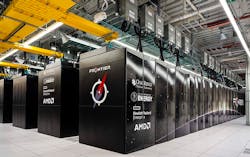The future of supercomputing and high performance computing (HPC) will be need to be driven by the hyperscale operators, as the scientific community, traditional driver of HPC, lacks the financial clout to be the prime mover, according to Professor Daniel Reed, the keynote speaker at this week's ISC High Performance conference in Hamburg, Germany.
“The leading edge HPC market is too small, the procurements are too infrequent, the funding is too small, and the financial risk to vendors is too high, while the size and scale of the hyperscaler and deep learning markets are too large to ignore,” says Reed, the Presidential Professor in Computational Science at the University of Utah and chair of the U.S. National Science Board.
HPC on demand is becoming an important part of the business world, and it is rapidly being joined by AI/ML on demand. Google, Amazon Web Servics, Microsoft, Oracle and others are adding significant AI capabilities that can be made available to any customer with the wherewithal to make the investment in those services.
Second tier cloud providers and specialty providers are also getting into the AI/ML space by providing not just on-demand capabilities but also colocation services that can support the power and cooling demands of building and training Large Language Models (LLM) and deploying the inference engines business are demanding.
Reed, in his paper Reinventing High Performance Computing: Challenges and Opportunities, makes it clear that new technologies, a new perspective, and a better understanding how future development will be funded, is necessary. To achieve this desired future Reed and co-authors Jack Dongarra of Oak Ridge Laboratory and computer scientist Dennis Gannon, propose six maxims to guide not just future development for HPC but also its use.
Maxim One: Semiconductor constraints dictate new approaches
The days of throwing more conventional CPUs and GPUs at the problem are coming to an end. The limitations of current architectures plus the cost of developing new fabs should be driving standardization for chiplet designs that can be used in standardized HPC architectures.
Maxim Two: End-to-end hardware/software co-design is essential
The future is in application-designed HPC, including custom processors designed for software solutions, which we are already seeing in many of the AI startup companies we recently covered. Reed also believes that a significant government investment in research, along with hardware vendors and superscalers will be necessary. The DOE’s recent investment in new cooling technologies is a good example of this.
Maxim Three: Prototyping at scale is required to test new ideas
Custom silicon and new software ideas will need to be built and tested to explore the most effective way to get to the next level. This means taking risks, and the government and the big cloud players will need to be willing to take on those risks to find the next generation of answers.
Maxim Four: The space of leading edge HPC applications is far broader now than in the past.
This is a statement of fact The focus of HPC applications continue to expand after the increased visibility of the technology as it was used in the design of COVID-19 vaccines has made businesses actively look for ways that HPC can solve their everyday business problems.
Maxim Five: Cloud economics have changed the supply chain ecosystem.
Annual superscaler spending on hardware dwarfs the amount of money budgeted every few years to build the current technology supercomputers. It will be important for governments and businesses to collaborate with the cloud operators and smartphone developers on the next generation of hardware and HPC services.
Maxim Six: The societal implications of technical issues really matter.
It used to be said that computing was touching on every aspect of our lives. That is now high performance computing, from vaccine design to daily weather forecasting, our lives are constantly being touched and influenced by HPC. AI use will increase that interaction and the ethical considerations of the impact of this cutting edge technology will require constant oversight.
The belief is that we are at another crossroads in the design and use of computing. Commoditization got us to this point, but the next generation of HPC will likely be purpose built to solve specific problems and classes of problems. Change is coming.
About the Author



